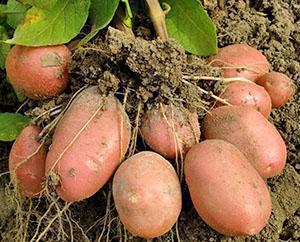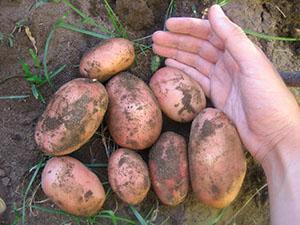Early potato varieties - general information
 More than 260 varieties of potatoes are grown in Russia. They differ among themselves in the group of ripeness, yield and disease resistance. Early varieties of potatoes are especially popular with Russian gardeners, due to their short ripening times.
More than 260 varieties of potatoes are grown in Russia. They differ among themselves in the group of ripeness, yield and disease resistance. Early varieties of potatoes are especially popular with Russian gardeners, due to their short ripening times.

The ripening period of a variety most often depends on the quality of the seed material, the timing of planting, a sufficient amount of moisture and useful elements in the soil, the degree of protection of plants from parasites and diseases, as well as weather conditions.
The best varieties of early potatoes that are cultivated in Russia are:
- RedScarlet;
- Bellarosa;
- Gala;
- Adretta;
- Karatop;
- Zhukovsky early.
Experienced gardeners use several early varieties of potatoes for planting. First, under different weather conditions, each variety behaves differently. And it is difficult to predict which one will give the best result. Secondly, for cooking, it is also advisable to use different varieties: for a salad, a hard variety is better, and for mashed potatoes, it is better to take potatoes that boil well.
Read also:potato gratin in the oven recipe with photo.
Red Scarlet variety
 An early high-yielding table variety imported from Holland. The ripening period for Red Scarlet potatoes is 45–70 days. Main characteristics:
An early high-yielding table variety imported from Holland. The ripening period for Red Scarlet potatoes is 45–70 days. Main characteristics:
- Root crops are large, elongated-oval, weighing 85–120 g. The peel is red, the surface is smooth, with shallow eyes.
- The pulp is yellow, does not darken with mechanical damage. The color does not change after heat treatment. During the cooking process, Red Scarlet potatoes do not tend to darken and do not boil over.
- The starch content is 10-15%.
- Good resistance to drought, diseases (viruses, golden potato nematode, late blight, leaf rolling, potato cancer).
- Productivity - 400 kg / ha.
- Stores well in winter.
To ensure high yields of Red Scarlet potatoes, the soil should be well loosened in the area where the tubers are located for the unhindered penetration of moisture and air. This has a beneficial effect on the formation of a good root system and strong tops.
Bellarosa variety
 A high-yielding early variety bred by German breeders. The ripening period from planting to harvest is 45-60 days. Main characteristics of Bellarosa potatoes:
A high-yielding early variety bred by German breeders. The ripening period from planting to harvest is 45-60 days. Main characteristics of Bellarosa potatoes:
- The tubers are large, oval in shape, weighing about 200 g. The peel is pink, the surface is rough, with a few small eyes.
- The pulp is yellowish, does not darken during cooking, has a low susceptibility to mechanical damage. Bellarosa potato variety boils well, has a medium-sweet taste.
- The starch content is 15.7%.
- Very high resistance to diseases (viruses, nematodes, potato cancer, leaf curling) and drought.
- The yield is 400 kg / ha.
- Keeping potatoes good.
In more southerly areas, you can harvest 2 crops of Bellarosa potatoes per season. To do this, after harvesting the first harvest in early July, you can replant the vacated areas. The second crop should ripen in early September.
Gala potato variety
 Early ripe variety. It takes 70–80 days from planting to ripening. Gala Potato Description:
Early ripe variety. It takes 70–80 days from planting to ripening. Gala Potato Description:
- Root crops of medium size, weighing 100-120 g, have a round-oval or oval shape. The peel is yellowish, the surface is smooth, with shallow eyes.
- The color of the flesh ranges from light yellow to dark yellow. Has good taste. It does not boil over and does not darken during cooking.
- The starch content is low 11-13%, therefore it is suitable for dietary nutrition.
- One of the main characteristics of the Gala potato variety is good resistance to mechanical damage and scab.
However, plants are prone to infection by the fungus rhizoctoniae, therefore, they require mandatory dressing; - Productivity - 340-600 kg / ha;
- Keeps well in winter.
2 weeks before harvesting Gala potatoes, it is recommended to first completely remove the tops. This contributes to the long shelf life of the tubers in good condition.
Adretta variety
 Medium early high-yielding table variety brought to Russia from Germany. Ripening occurs 60–80 days after planting. The main characteristics of the Adretta potato variety:
Medium early high-yielding table variety brought to Russia from Germany. Ripening occurs 60–80 days after planting. The main characteristics of the Adretta potato variety:
- The tubers have an oval shape, weighing 120-140 g. The peel is yellow, with sparse small eyes.
- The pulp is pale yellow, with excellent taste. It boils well when cooking.
- The starch content is average - about 16%.
- The Adretta variety has increased resistance to many diseases, pests, rot and low temperatures. However, it is susceptible to such diseases: scab, rhizoctonia, late blight and black leg.
- The yield is 450 kg / ha.
- Suitable for long-term storage.
Since the Adretta potato variety is medium early, it is advisable not to overexpose it in the soil in order to avoid rotting the tubers during the period of heavy autumn rains.
Caratop variety
 Early ripe high-yielding table variety. It takes 50–70 days from planting to ripening. The main characteristics of the potato variety Karatop:
Early ripe high-yielding table variety. It takes 50–70 days from planting to ripening. The main characteristics of the potato variety Karatop:
- The tubers are small, oval-round, weighing 90–100 g. The peel is yellow, the surface is smooth, with small eyes.
- The pulp is pale yellow, with good taste. The potato variety Karatop retains a relatively firm structure after boiling and a pleasant yellow color.
- Starch content 14.4%.
- High resistance to viral and other diseases (nematode, potato cancer).
- Productivity - 450 kg / ha.
- Has good keeping quality.
For good yields, it is advisable to plant the Karatop potato variety on an area where legumes and herbs used to grow, and lupines on sandy soils.
Potato variety Zhukovsky early
 An early early ripening table potato variety, bred by domestic breeders. The ripening period is 60 days. The main characteristics of Zhukovsky early potatoes:
An early early ripening table potato variety, bred by domestic breeders. The ripening period is 60 days. The main characteristics of Zhukovsky early potatoes:
- The tubers are large, oval, weighing 100–150 g. The surface is smooth, light pink or beige, with few pink eyes.
- The pulp is white, does not darken when cut. Early Zhukovsky potatoes are not boiled soft and are suitable for frying.
- The starch content is 15%.
- Particularly unpretentious and resistant to most diseases (nematode, scab, rhizoctonia). High resistance to drought and low temperatures.
- The yield is 380 kg / ha.
- With moderate humidity and temperature, it can persist until mid-spring.
Early Zhukovsky potatoes can be planted in April. However, to protect against frost and to increase the soil temperature, it is advisable to cover the planted potatoes with agrofibre. When the threat of frost has passed and the air temperature rises, the cover is removed.
It is obvious that planting early potato varieties has a number of undeniable advantages.
- The likelihood of combining the biological properties of the variety with suitable weather conditions. Potatoes do not succumb to the damaging effects of drought in late summer.
- Young plants do not have time to be damaged by the Colorado potato beetle, and mature ones - by carriers of viral diseases (aphids, cicadas).
- Few chemical treatments. As a result, the pollution of the external environment and potatoes with pesticides decreases, as well as the cost of goods.
- Limited amount of labor intensivewatering.
However, by planting only varieties of early ripening periods, you can lose without guessing with the weather. Therefore, it is recommended to allocate 50% of the site for early potatoes, and plant the remaining part evenly with mid-season and mid-late varieties.
Regarding the cultivation of potatoes, the author speaks of the many varieties in circulation. Therefore, it is impossible to describe everything. Some additions to the Karatop variety. It happened to get a few extra-class nodules. Seeds the size of a pigeon's testicle have developed into bushes with not very dense foliage and numerous thin branches over the season, which is even better. But in one of 10 nests during harvesting there were 50 medium-sized tubers without fines. Of course, ideal conditions were created for reproduction, but only one bush gave a record harvest. Over the next three years, this variety produced an average of 18 tubers per nest. But this is with high hilling and sowing through 40-50 cm in a row. Row spacing 70 cm.
Finnish selection of Jarl's ultra-early variety. After 50 days, you can harvest. A bush caught in the morning frost recovers quickly. But it was a surprise that the plot left for seeds was green until the end of August. At the same time, the potatoes continued to grow. From under each bush I received 8-10 huge potatoes with thin skin, the filling continued. I saved it for seeds, keeping it for 10 days in a dark place to strengthen the peel. It is impossible to cut for landing, it rots in the ground.